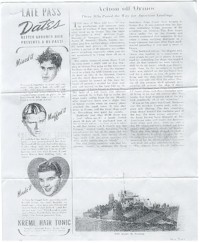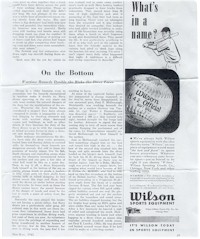

 |
 |
U.S.S. Allen M. Sumner
DD-692
Action off Ormoc
Three DDs Paved the Way for American
Landings
(An article from OUR NAVY magazine for Mid-May 1945)
 |
 |
"The men of Mars will have to step up
production and renovate their methods of warfare if they want to beat what went
on in Ormoc Bay the night if December 2, 1944," declared Cmdr. Norman J.
Sampson, skipper of the US ALLEN M. SUMNER. "Shells, bombs, machine gun
fire, surface ships, submarines, PT boats and planes, all encountered within a
period of 30 minutes are rather nerve wracking, especially when you are not
accustomed to taking them all on at once."
The action occurred when three Yank tin cans made a night
raid on Jap shipping in Ormoc Bay prior to the American landings in that area.
It was the engagement in which the US COOPER was sunk. At dusk on Dec. 2, the
SUMNER, COOPER and the third destroyer (which, we regret, cannot be named at
this time because of security) sortied for their mission and started the long
trip up the west coast of Leyte Island to Ormoc Bay. The light of the full moon
was diffused just enough by a high fog to make the ships easily visible from the
air. Shortly after departure there was a slight hint of future events when an
enemy plane attacked the small force. It was shot down in flames, and the three
ships sped on. Everything was quiet for awhile.
"Suddenly just after 23:00 there was a loud 'whoo-o-sh':
a bomb landed 30 feet of the starboard bow of the SUMNER and in more time than
it takes to tell fire broke out. I clearly saw the Frances," related Cmdr,
Sampson, "as it passed over the top of the mast and the main battery went
into action. From then until 3:06 the next morning we were under continuous air
attack."
The real battle however was just beginning: exactly at
midnight the three American ships found their targets in Ormoc Bay. It was
guessed that the Japs were unloading troops because of the persistent air
attacks. The first target taken under fire by the COOPER and SUMNER confirmed
that suspicion. It was either a troop carrying destroyer or a troop transport
but soon after the Yank shells started pounding it was just a mass of flames.
"Our laddered salvos," the skipper said, "were
also landing in a warehouse or shed which we saw go to pieces. A crane used for
unloading Jap ships also toppled over. At that moment we were forced to shift to
an air target which was dangerously close. In the meantime a torpedo wake was
sighted on the starboard bow and for a minute or two all guns were firing and
the ship was heeling crazily first to one side and then the other. Suring all
this rumpus shell splashes were popping all around the ship. I didn't realize at
the time that ships, submarines, PT boats, plane and shore batteries were all
firing at us, nor did anyone else. The bombs that kept dropping out of the sky
took practically all of our attention."
It was at this point that Cmdr. Sampson saw the stricken
COOPER sink, with her guns still blazing. The two remaining ships closed toward
the northern part of the bay, the main enemy objectives of the foray having been
disposed of. The Americans were still under fire however from ships and shore
batteries and a Jap PT which suddenly dashed out from shore was promptly sunk by
gunfire. The two ships turned to find a Jap destroyer heading directly for the
SUMNER. Fortunately it was clearly silhouetted by the flames of the transport
and shed. All guns commenced firing.
"The tracers from the 40 millimeter guns were so close
together that a truck could have driven across the path of their arching
destruction. Those so called supermen and their ship didn't last long. My last
glimpse of the scene was a white haze of smothered steam rising slowly from the
water. The spot where a Jap destroyer had been was now calm and peaceful. Our
immediate vicinity however was not peaceful. Shells were still dropping too
close for comfort. It was time to start thinking of getting out of there - and
fast. Jap planes had begun to strafe us after completing their bombing runs and
there were some uncomfortable near misses."
The SUMNER and her companion shot down eight Jap aircraft
during these attacks.
"Each man did the job for which he was trained and in
some cases another man's work as well. Main battery loaders practically dropped
in their tracks from exhaustion. They moved more than 35 tons of high explosives
and sent it screaming at the Japs they had so long been hunting. There were no
wimpers from the wounded and it was evident they desired no sympathy. One
lookout who had often needed prodding to make use of his binoculars was actually
using them when a bomb or shell fragment struck and demolished them. They saved
his life. It was particularly gratifying to all of us who took part in the
episode to learn that the friendly natives in the vicinity had piled up dead
Japs along the beached the next morning. I'm sorry I can't report more fully on
what happened that night. A nightmare is a difficult and trying experience to
describe."
Webmasters note: the unnamed destroyer was the USS MOALE (DD-693)
Many thanks to Ron Babuka who sent this article on to us.